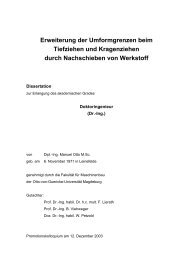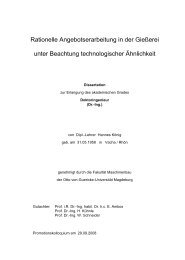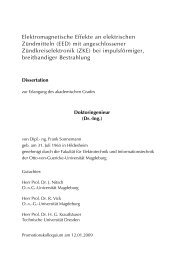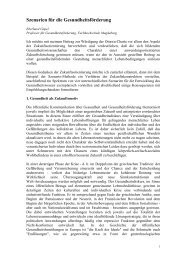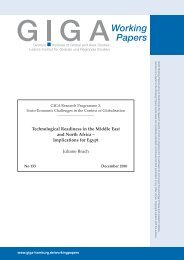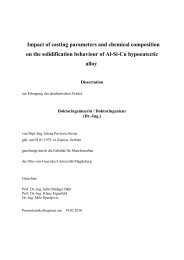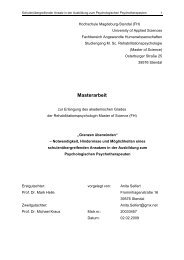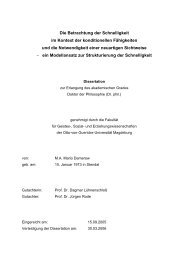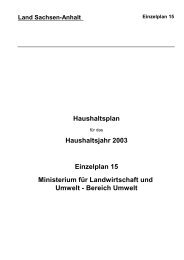Chapter 1
Chapter 1
Chapter 1
Create successful ePaper yourself
Turn your PDF publications into a flip-book with our unique Google optimized e-Paper software.
on a pilot basis and is studying the feasibility of using pri- health. The Poverty Assessment Report (1995) identifies<br />
vate concessions for new sewage treatment facilities. Private poverty as a rural phenomenon. A comparison of social indisubcontracting<br />
for O&M has not been used in the transport cators by region (1988) shows significant disparities: fertilsector<br />
as much as it has for other infrastructure services. ity rates and child mortality rates in the central west and<br />
Recurrent road maintenance is still largely done by public south are roughly double those in Tunis, and the share of<br />
sector force account, even though there are cost-efficient married women with no education is two times higher in the<br />
opportunities for private sector contracts in road rehabilita- northwest and central west than in Tunis. Every study on the<br />
tion and network strengthening. Chile, following Canada's subject demonstrates the strong and beneficial links<br />
example, uses global maintenance contracts, whereby a between more years of schooling and better basic health<br />
series of works is consolidated under a single private con- care with reduced fertility rates and poverty alleviation.<br />
tract. Private contractors offer competitive prices and the Tunisia's success at reducing fertility rates and reducing the<br />
global nature of the contracts reduces the costs of manag- rate of absolute poverty from 11.2 percent in 1985 to 7.4<br />
ing and supervising numerous small contracts. percent in 1990 is due in part to its social expenditure policies.<br />
The key challenge now, is to further improve the tar-<br />
Social policies and expenditures geting of expenditures for the poorest groups.<br />
Since independence, the state has devoted higher public<br />
expenditures for social policies than most middle-income<br />
Education policies<br />
countries. The legacy of the Bourguiba era and the present As knowledge-intensive production technologies displace<br />
government's continued recognition of the importance of the old methods, education systems need to be redesigned<br />
social measures has helped Tunisia realize an improved stan- to support the education and permanent training of the<br />
dard of living. Literacy rates increased from 35 percent at labor force. Education is also a decisive factor in halting the<br />
independence to 65 percent today, life expectancy went declining wages of unskilled workers, and it is an area where<br />
from sixty-three years in 1980 to sixty-eight years in 1992 government policies and expenditures play a critical role,<br />
and the population growth rate has fallen from about 2.4 particularly at the primary level.<br />
percent a year to under 2.0 percent a year Income distribu- Assessing how much progress has been achieved in a<br />
tion has been continuously improving: the Gini coefficient country's development of human capital is difficult, because<br />
fell from 0.43 to 0.40 between 1985 and 1990, and average authorities often report the number of students registered<br />
per capita expenditures for the lowest decile of the popula- at the beginning of each school year (enrollment rates), even<br />
tion moved closer to mean expenditures for the country as though the actual number that attend and complete school<br />
a whole. during the year may be much lower (completion rates).<br />
The level of government's budgetary expenditures for Table 2.5 presents the most recent data available and indisocial<br />
policies has remained consistently high even during cates the level of human capital of the adult population<br />
the years of stabilization and adjustment, amounting to 5-6 across regions in the mid-1980s by evaluating education<br />
percent of GDP for education and 2.2 percent of GDP for attainment rates.<br />
TABLE 2.5<br />
Trends In educational attainment by region, 1985<br />
(Leve attained by percentage of population over age 25)<br />
Region No school Primary completed Secondary completed Higher completed Average years of school<br />
Middle East and North Africa 52.8 26.5 16.0 4.8 3.51<br />
Tunisia 1985 66.3 18.9 12.0 2.8 2.1<br />
Sub-SaharanAfrica 48.1 41.7 9.3 1.0 2.67<br />
Latin America and Caribbean 22.4 56.6 13.9 7.1 4.47<br />
East Asia and Pacific 23.6 51.3 18.8 6.3 5.19<br />
Source: The 1985 data for Tunisia are fiom Barro and Lee 1993. Comparative data for the age group I5 to 25 was not avaiiable across regions. Tunisia's attainmrent averages are bwer<br />
than the average for the region, due to the hgher attainment rates of such countries as Turkey. Israel, Syria, and Jordan. (Egpt and Morocco were not induded in the group due to data<br />
problems.) Tunisia has, however, made tremendous progress in reduang the share of 'no school' from 94 percent in 1960 to 66 percent in 1985.<br />
20 TuNIs1AS GLOBAL INTEGRAnON AND SuSNABLE DEVELOPMENT. STATEGIC CHOICES FOR THE 2 1ST CENTURY




